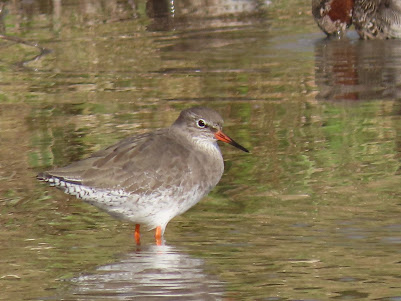This week I only had one day free, and it happened to be a fine day between two days of forecasted heavy rain. I therefore felt I had to make the most of it as I hadn't been out for a walk at all this week.
Recently, I read a local blog recounting a visit to Avalon Marshes, an area I'd visited several years ago on the Somerset levels where I had some close encounters with some bearded tits. Not having seen one of this species this year, I decided it would be make a nice day out. My previous visit was on a Saturday morning in mid-October, when I was able to leave at 7 am. but today being a weekday I wanted to avoid the rush hour if I could ,so left an hour later. Even so I was surprised that I wasn't held up along the A419 dual carriageway down to the M4. In fact I had a very good journey down to Somerset, apart from a slight delay just before the junction with the M5 where the exit to the northbound motorway was closed off.
I arrived at just before 10 am; the car park had been closed for resurfacing but it was due to re-open today so that worked well for me. There were already a good number of cars there and I began to wonder if the boardwalk to the Island hide I was aiming for, would be busy with birders, particularly in view of the fact that a spotted crake had been reported a couple of days ago. This particular area is a favourite place to spot bearded tits, which are encouraged onto the board walk to feed from the grit and food put down for them.
However, there were just three people there, plus a lady with a clipboard who I learned was part of a group of people recording numbers of bearded tits. Despite a sunny drive down to Somerset, it had now clouded over and although not cold, it felt as if there might be a bit of rain around before long. I stood on the board walk with my camera, prepared for a bit of a wait, but it was only ten minutes before the 'pinging' sound of bearded tits was heard and first one then two, then a flock of about twelve birds flew into the reeds nearby and proceeded to climb to the top of the reeds and then fly to some dead branches protruding above the reedbed. . These are one of my favourite birds, especially the male with his black 'moustache'. They flew off in groups and although you could hear them although they were not always visible.
Hoping that they would come back either close by in the reeds or to visit the boardwalk, I continued to wait. occasionally conversing with the other two photographers present.. Sure enough I soon spotted a male emerging through the reeds onto the boardwalk where he proceeded to feed for several minutes undisturbed. A female later joined him. For the next half hour or so I watched several individuals popping in and out of the reeds every so often and at one point there were five birds; three males and two females.

When there were no more birds left on the boardwalk, I decided to go and explore more of the reserve' the lady recorder had suggested visiting the North hide which my map showed me was at the far end of the reserve. As I turned onto the track signposted 'hides' I spotted a couple looking at something moving in the grass alongside the hedge. A small dark furry animal -- a mink! It seemed quite unaware of being watched as it moved amongst the grass. Although quite 'cute' looking, these non native species are unwelcome visitors to waterways, because of their predation of creatures such as water voles and young kingfishers,
I left it to continue its journey and carried on along the track, passing a wooden carving of a flock of starlings, as a reminder of the large starling murmurations which are well known in the Avalon marshes area.
I caught up with another gentleman and we got chatting; I enquired if he was local but he informed me that he'd driven down from Swindon! He'd been told that a large flock of up to 50 cattle egrets were currently with a herd of cattle at the end of the track so I decided to carry on past the North Hide to find them. We saw half a dozen in a field on our left before coming to a bridge from where we counted a further 30 - 40 birds, all feeding among some cattle. I've only ever seen one or two at once before, so this was quite a spectacle.
You couldn't get too close as they were very nervous and easily took to the air before resettling again. We also saw three great white egrets along the route to the hides.
In the end we didn't visit any other hide as there was a lot of ' strimming' going on which would deter much bird presence around the area, in any case it was nearly lunch time so I decided to return to the car and eat my picnic before setting off for home. Another enjoyable and memorable trip.
































